Printful and Redbubble are two giants in the print-on-demand game, but which one is the better choice?
We’ve spent hours researching and comparing these platforms to give you a clear answer for your print-on-demand needs. After reviewing their features, pricing, and usability, here’s the verdict:
Printful vs. Redbubble: Quick Verdict
- Printful – Best for building your own brand and maximizing profit margins. Ideal for entrepreneurs running their own online stores.
- Redbubble – Best for artists who want a hands-off approach. Perfect for reaching an audience without worrying about marketing.
In this review, I’ll compare Printful and Redbubble across key factors like profit potential, ease of use, product quality, and more—so you can choose the best option for your goals.
Quick Verdict
In the end Printful is the more all around print on demand solution. Both allow custom product creation and selling but Printful has more integrations, better mockup generator and more control over branding and shipping so it’s better for serious ecommerce businesses.
Redbubble is great as a standalone marketplace with built in customer base and easier setup process so it’s perfect for artists who want to monetize their work without managing their own online store. But it has no integrations and limited branding options so not suitable for scaling.
So choose Printful if you want a branded e-commerce store with multiple sales channels or Redbubble if you want a ready made marketplace to sell your designs. Continue reading for more details.
Printful's Pros and Cons
Last but not least, let's take a look at the pros and cons of both platforms.
First up, Printful:
Printful's Pros and Cons
Pros 👍
- Intuitive interface
- No monthly fees or setup costs
- Custom branding options
- Mobile app for iOS and Android
- Quick order processing
- Wide integration options
- Quality products
- Responsive customer support
- Sample product discounts
Cons 👎
- Higher base prices than competitors
- No bulk product editing
- Limited refund options
- Restricted shipping for some items
- No built-in analytics
Redbubble's Pros and Cons
Pros 👍
- Easy to use platform
- No setup fees
- Built-in marketplace
- Built-in analytics
- Quality product range
- Strong customer support
- Bulk product editing
- Helpful user guides
Cons 👎
- Fluctuating product prices
- No product branding options
- Monthly payment delays
- No eCommerce integrations
- Variable pricing by product type
- High marketplace competition
How Printful Works?
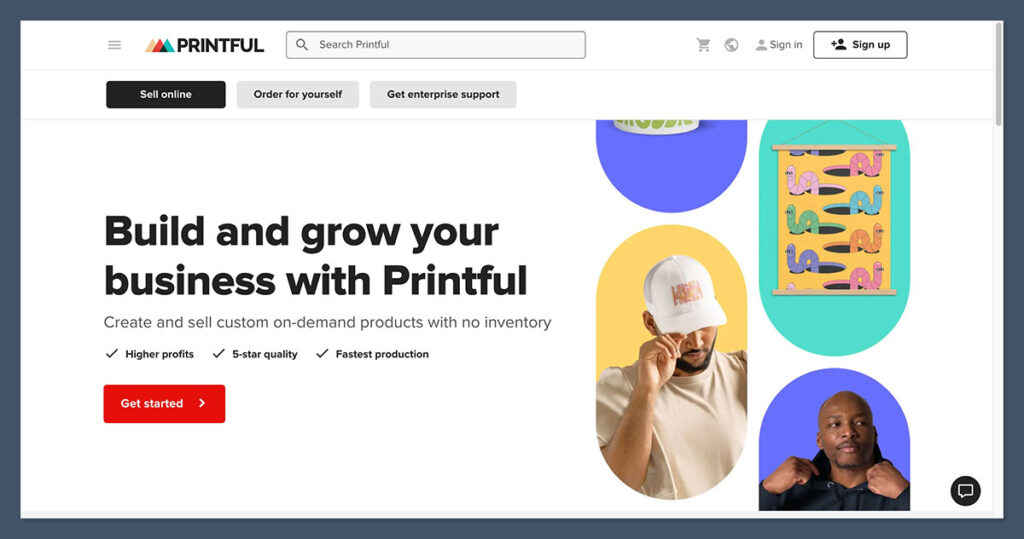
Founded back in 2013, Printful is an easy-to-use online platform that allows sellers to adopt the print on demand (POD) dropshipping method.
Printful is a fabulous option for creatives, entrepreneurs, enterprises, and influencers alike; in fact, anyone looking to craft custom products to sell online.
There's no setup cost required. You just integrate your eCommerce business with Printful. From there, you can begin adding new products to your product catalog for customers to purchase from your online shop.
Then, when a customer purchases something, Printful automatically pings the order off for fulfillment.
This will go to one of Printful's in-house factories or partner facilities. Lastly, the product(s) are shipped directly to your customer's doorstep.
Simple, right?
When it comes to design creation, you can do this offline and then upload your finished work to your Printful account.
Alternatively, you can use Printful's mockup generator to create simple designs. Rest assured, you can double-check how your design looks on Printful's products before listing them for sale.
Alternatively, if you don't boast the ‘design gene' but want to get in on the POD action, opt for Printful's graphic design service. Just submit a request describing your vision, and a designer will bring it to life for you.
On top of that, Printful also offers separate warehousing and order fulfillment services, where you can order products, store them, and ship them off after they've been printed.
This may come in handy once your business starts to grow, as you'll be able to turn around orders quicker.
For a full Printful review, click here.
How Redbubble Works?
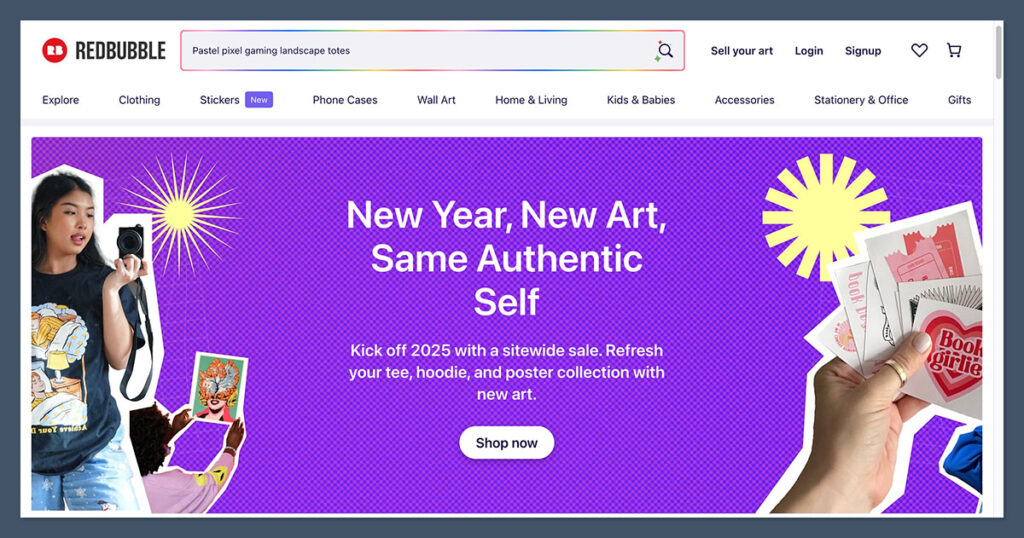
Founded in 2006, Redbubble is also a print on demand solution. It works much the same way as Printful.
However, Redbubble doesn't enable you to integrate with your own website. Instead, Redbubble is a marketplace where buyers can come and purchase customized products you've created and listed directly on Redbubble.
As such, Redbubble is more geared towards designers. They aim to provide creatives with a convenient way of monetizing their artwork.
In fact, at the time of writing, more than 700,000 artists use this platform- they can't all be wrong, right?
This is how Redbubble works (for online sellers):
- First off, you create a Redbubble account.
- Next, you upload your artwork.
- When you're happy with your design, write a title and description for your product, and assign as many relevant tags (keywords) as possible.
- Lastly, you publish your product.
- At this point, it's available for sale on Redbubble.
Before you start designing, you'll need to familiarize yourself with each product's unique design model – especially its dimensions.
Then, similar to Printful, you can create designs offline and upload your finished work to your Redbubble account.
You'll be pleased to hear that Redbubble accepts various media and art types, so feel free to get those creative juices flowing!
That said, you'll have to use high-resolution image files to ensure high-quality print quality. Also, if you're designing something with a transparent background, this image should be uploaded in a PNG file format.
Once you've uploaded your designs, you can simultaneously edit your design across multiple products. Needless to say, this saves you a ton of time.
From your Redbubble storefront, you can list up to 60 different products for sale!
From the customer's point of view, they head to Redbubble and browse for whatever they're looking for.
If they come across your artwork and like it, Redbubble then prints it onto the appropriate item and ships it to the customer.
Redbubble then credits your account with a percentage of the sale price (AKA a royalty). Then, once a month, Redbubble releases these funds into either your Paypal or bank account, so long as you've accumulated $20 (or more).
If you don't meet this threshold, you'll have to wait a year for the funds to be released (providing it equates to $2 or more).
Printful vs. Redbubble: Key Features Comparison
| Feature | Printful | Redbubble |
|---|---|---|
| Business Model | Integrates with your own online store | Standalone marketplace |
| Customization | Full branding options (labels, packaging) | No branding options |
| Setup Costs | Free to start (base product costs apply) | Free to start |
| Profit Margins | Seller sets the price and profit margins | Lower margins due to Redbubble fees |
| Integrations | Shopify, Etsy, WooCommerce, and more | None (standalone platform) |
| Traffic Source | You market your store | Built-in marketplace traffic |
| Ease of Use | Requires setup (store, integrations, etc.) | Easier (upload and start selling) |
| Fulfillment Time | 2–7 days | 3–10 days |
| Product Range | 150+ products | ~60 products |
Printful vs Redbubble: Pricing
Now that we've covered the basics let's look at how much it will cost you to get up and running on either platform…
Printful
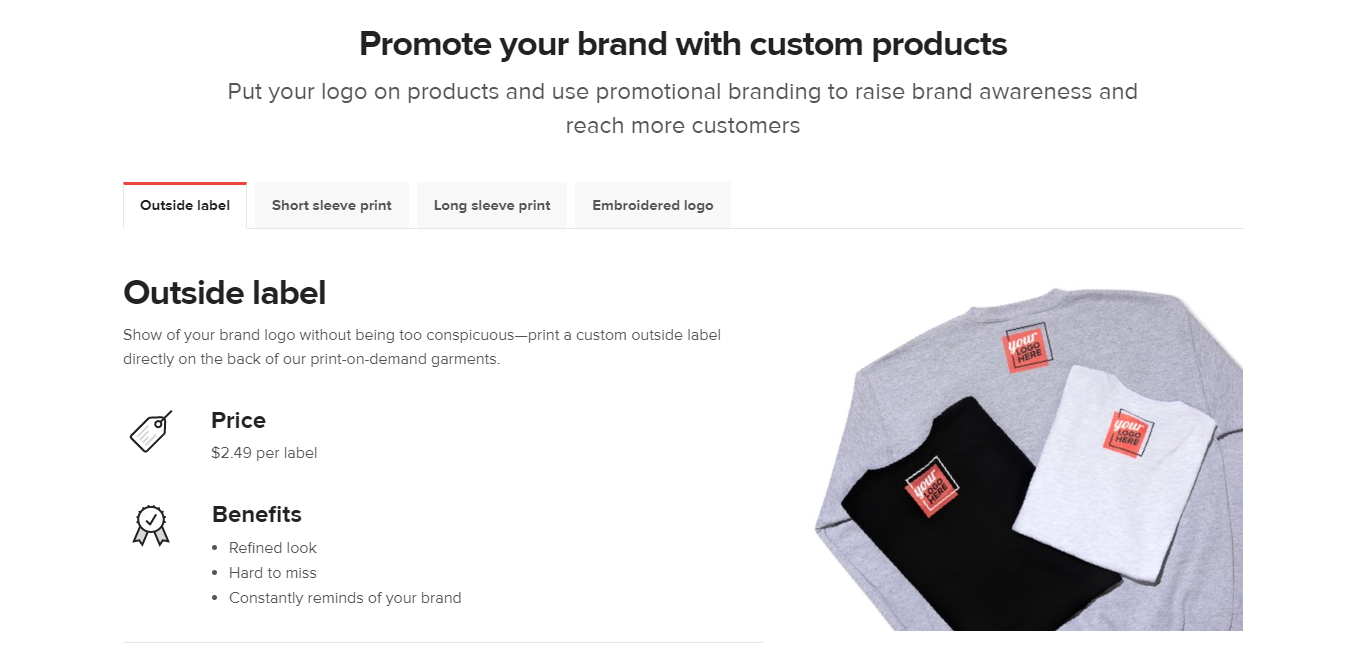
As of January 2025, Printful offers a single membership option – the Printful Growth plan ($24.99/month, or free with $12K in sales over 12 months).
Benefits include:
- Up to 33% off all products
- 9% off product branding
- 25% off sample orders
- Free digitization for sample orders
- DTG (Direct-to-Garment) product pricing reduced by up to 20%
Base prices without the Growth plan can be found in Printful's product catalog. These include product and printing costs, but not shipping and taxes.
Average base costs:
- T-shirts, leggings, dresses, hoodies: $7-$55
- Wall art: $7-$30
- Hats: ~$15.50
- Mugs: ~$8
- Tote bags and other bags: $10-$25
- Pillows: ~$14
- Towels: ~$25
- Phone cases: ~$10
Base prices vary by fulfillment location (Europe, USA, Japan, or Australia).
Additional branding costs:
- Custom inside label: $2.49
- Custom outside label: $2.49
- Custom short sleeve print: $2.49 per sleeve
- Custom long sleeve print: $5.95 per sleeve
- Embroidered logo: $2.95 per additional placement
Redbubble
Apparently, Redbubble's product prices change every now and then, so be sure to check the current rates for the products you want to sell before setting your margins.
That said, if you're looking to sell clothes, expect to pay a base cost of anywhere between $15 and $45.
Interestingly, Redbubble's home decor is their most expensive product category, with duvet covers costing over $100.
If you want to sell wall art, the cost varies between $14 and $30 depending on the print and card type. In contrast, metal prints are much more expensive, ranging between $50 and $300.
How much does it cost to produce and sell products on each platform? Here’s a quick price breakdown for common items:
| Product Type | Printful (Base Price) | Redbubble (Base Price) |
|---|---|---|
| T-Shirts | $7–$25 | $15–$45 |
| Hoodies | $20–$55 | $35–$65 |
| Wall Art (Posters) | $7–$30 | $14–$30 |
| Mugs | ~$8 | $12–$20 |
| Duvet Covers | N/A | $100+ |
Printful vs Redbubble: Integrations
If you're running an online business already, you'll want a POD platform that integrates with the website builder/digital shopping cart/eCommerce platform/online marketplace you're already using.
In light of that, we've listed the native integrations that both Printful and Redbubble come with:
Printful
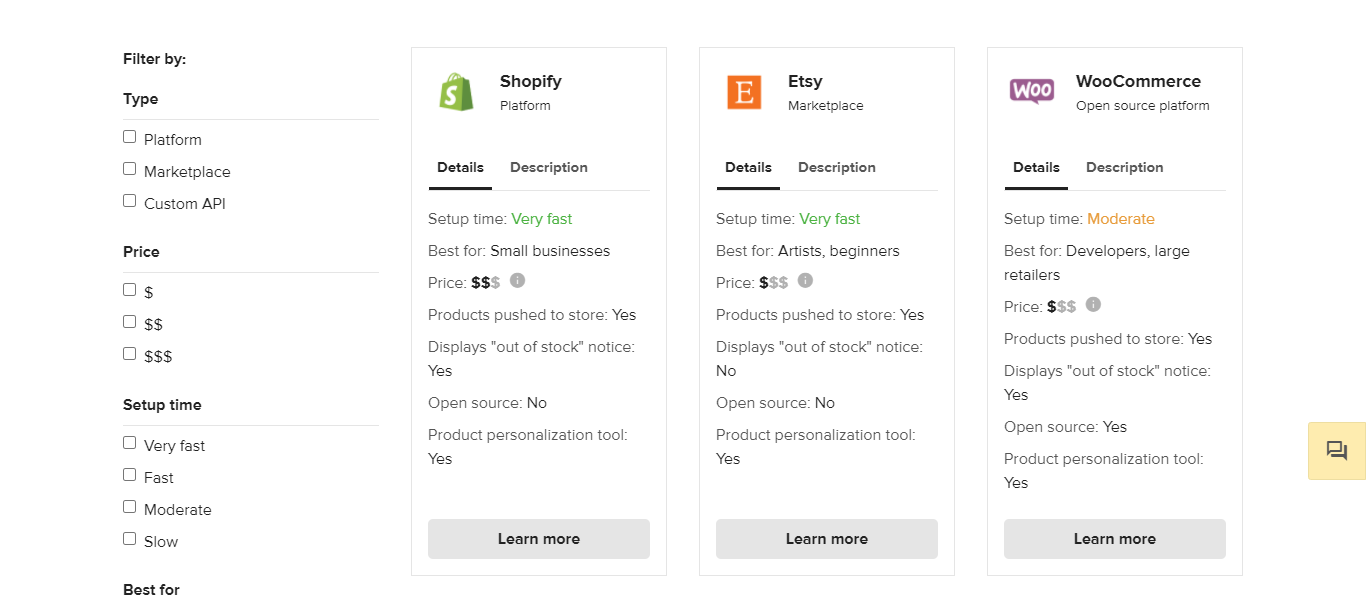
- Shopify
- Etsy
- WooCommerce/ WordPress
- Wix
- Squarespace
- Webflow
- Ecwid
- BigCommerce
- PrestaShop
- Weebly
- Amazon
- eBay
- Big Cartel
- Wish
- Magento
- Storenvy
- Bonanza
- 3dcart
- Launch Cart
Redbubble
Unfortunately, at the time of writing, Redbubble doesn't come with any native integrations that enable you to connect your Shopify store (or any eCommerce shop for that matter) with your Redbubble account.
This is because Redbubble is explicitly designed to be a fully-featured online marketplace, that's what it knows, and consequently, that's what they stick to.
That said, Redbubble supports third-party tools like Google Analytics and Google Maps.
Printful vs Redbubble: Fulfillment and Shipping
How quickly can customers expect their orders? Check out the average fulfillment and delivery times:
| Region | Printful (Avg. Time) | Redbubble (Avg. Time) |
|---|---|---|
| United States | 3–4 days | 3–7 days |
| United Kingdom | 2–5 days | 3–7 days |
| Europe | 4–6 days | 5–10 days |
| Rest of the World | 7–14 days | 10+ days |
The timing and reliability of any print on demand service's fulfillment and shipping are imperative to the success of your online business, so let's see how Printful and Redbubble compare:
Printful
Regarding fulfillment, Printful takes an average of two to seven days to manufacture and fulfill apparel orders. In contrast, non-apparel products are turned around a little quicker, with an average time of two to five business days.
It takes roughly four business days to ship the package (depending on the delivery address). See below for more accurate delivery times.
Reportedly you can expect the following turnaround times for these destinations:
- The United Kingdom: Two to five days
- The United States: Three to four days
- France: Three to five days
- South America, Asia, and other European countries: Six to 14 days
Please note: As a seller, you'll have to pay for shipping, so be sure to factor that into your product pricing strategy, as you don't want this to eat into your profit margin.
The shipping cost varies depending on the weight of the products, shipping destination, and shipping method. Alternatively, you can set a flat shipping rate if that's easier.
How you handle shipping costs are up to you. You'll need to figure out the math to see whether it's more cost-effective to charge a fixed or fluctuating shipping fee.
Redbubble
Like Printful, Redbubble also ships globally. That said, they don't deliver to Cuba, Sudan, North Korea, Syria, or Crimea.
You can rely on reputable couriers to ship your customer orders, as Redbubble partners with services like DHL, UPS, and FedEx.
That said, shipping times vary depending on the customer's location, shipping method (standard or express), and product type.
However, local orders are sometimes shipped within less than two days. In contrast, orders traveling further afield can take up to three working days (or more).
Like Printful, Redbubble only ships on business days.
Redbubble also provides customers with an order tracker so that shoppers can keep an eye on their order's delivery status in real-time.
Interestingly, Redbubble's shipping costs fluctuate. But, as an online seller, you don't need to concern yourself with this as shipping is handled directly between Redbubble and your customer.
Shipping costs are calculated on the buyer's checkout page, which depends on their chosen shipping method, the origin and destination of the shipment, and the order's contents.
Printful vs Redbubble: Customer Support
No matter how easy-to-use a platform is, there's a good chance you'll have a question or two at some stage – especially when you're first starting out.
This is where knowing you can rely on high-quality customer service is worth its weight in gold. So, how do Printful and Redbubble measure up in this department?
Printful

Printful offers a variety of customer support channels. You can contact Printful's customer service team via email at [email protected].
On average, you'll receive a response within a day. Alternatively, you can send a support ticket via their ‘Contacts' page.
Pre-COVID, Printful also offered 24/7 live chat. At the time of writing, they're working to increase their chat availability to resume their 24/7 live support service.
You can access their live chat widget and launch a conversation with a Printful rep from the bottom-right corner of any Printful web page.
Or, if you prefer to go down the self-help route, Printful has an online help center brimming with helpful resources. Here you'll find plenty of articles, video tutorials, and answers to FAQs.
On top of that, Printful also has an active social media presence, most notably on Instagram, YouTube, and there's a Facebook group you can join.
This is a great place to connect with other Printful users, ask questions, and network with like-minded people.
Redbubble

Redbubble offers 24/7 customer support, but not via email or live chat. Instead, you'll have to send Redbubble a direct message via Twitter.
Reportedly, this gets a near-on instant response! Alternatively, you can ping over a customer support ticket. Typically speaking, you should receive a reply within 24 hours.
Alternatively, if you're looking to fix the issue yourself, Redbubble has a thorough help section for sellers and buyers alike.
Here's you'll find resources covering virtually every Redbubble procedure, so you should find what you're looking for here.
On top of that, you can also follow their social media handles across Instagram, Facebook, Tumblr, and Pinterest. This is worth doing if you want to stay up to date with all the latest Redbubble updates and news.
Printful vs Redbubble: Product Designs and Quality
The product and print quality of any POD platform are essential. They could shine in every other department, but if the end result is subpar, you won't get repeat customers!
So, let's see how Printful and Redbubble fair where quality is concerned…
Printful
Printful boasts state of the art printing equipment worth a whopping $27 million (roughly). This machinery helps to ensure they produce high-quality products.
That said, when you upload your design to Printful, always double-check to ensure you're happy with it and that you've uploaded the highest resolution file. Again, this helps guarantee a high-quality print.
Then, after your products are printed with your design, Printful checks your items for quality. On top of that, Printful is well-renown for sourcing their base products from first-rate brands, including Bayside, Gildan, Next Level Apparel, Hanes, and others.
Redbubble
Redbubble partners with various printing companies and fulfillment centers across the US, Australia, Canada, the UK, Germany, and the Netherlands.
All Redbubble products are ethically-sourced and have been carefully selected to ensure quality.
Also, a quick Google search tells us that generally, speaking, most customers are happy with the overall quality of Redbubble's prints and products.
Printful vs Redbubble: Packaging and Branding
If you're looking to establish an online brand, then listen up – this section is essential.
Printful
Printful prides itself on being a white-label platform, providing the foundations you need to build your own brand and strengthen it.
As such, Printful doesn't plaster its branding over your product packaging. Instead, there are a few customization options available to you.
For instance, you can upload your logo and any custom messaging for Printful to print on your packaging.
On top of that, you can insert a packing slip into each box containing product info and your branding.
While we're on the subject of packaging, it's worth noting, fragile items like frames are well-wrapped to protect from damage, and all products are finally packed into corrugated boxes.
Redbubble
Different from Printful, Redbubble's packaging varies depending on the item. For instance, the majority of apparel and stickers and shipped in poly bags.
In comparison, framed art is put into boxes and posters and smaller prints in tubes.
Also, unlike Printful, Redbubble's product packaging is slapped with Redbubble's branding, which we suppose makes sense considering your customers are purchasing directly from Redbubble's platform rather than from your own online store.
Alternatives to Printful and Redbubble
While Printful and Redbubble offer many competitive POD features, there are other great software alternatives to choose from.
For instance, Printify, Sellfy, Teespring, and Spocket. That said, let's see what these print-on-demand providers bring to the table.
Printful vs Redbubble vs Printify

Printify has over 1000 products to choose from, so you're bound to find something suitable for your product catalog! In comparison, Printful offers over 350 products, whereas Redbubble provides only 60.
They each also have a mockup generator that enables you to test simple designs on a 3D product image, which is excellent for getting a feel for your end product.
The easy drag and drop builders also makes Printify a good choice for beginners to design.
Across all three companies, design features are relatively standard across the board.
For example, you can pick whether a print appears on the front or back of an item, which colors to test your design on, upload images and clipart, and add custom text.
But, unlike Printful, Printify uses third-party fulfillment and printing services, which has its benefits and drawbacks.
First, this means you'll have to work with one of their partners instead of the brand directly.
So, if an issue occurs with an order, this can be a bit of a problem, as all communications will have to go through Printify first.
Redbubble works similarly by rerouting all print requests to third-party printers closest to the delivery location.
In contrast, Printful has its own printers and warehouses, so if an issue arises, it should get sorted quicker because third parties don't need consulting!
On the other hand, being able to handpick your supplier(s) means you can choose the best company for your needs.
Printify even lists Print Provider ratings to help you better understand who best to opt for. You’re also more likely to access quicker delivery times if you opt to work with a printer located nearer to your customers.
Moreover, you can request a sample to decide which supplier meets the quality of print you’re looking for. Sellers get a 20% discount on samples with Pritnful and free shipping to select locations.
In contrast, neither Printify nor Redbubble offers discounts on sample orders.
With Printify, you have a host of integrations you can use, including popular online marketplaces like Etsy and eBay. However, unlike Redbubble, you won't have direct access to an established market to sell from.
Printful vs Redbubble vs Spocket

While Spocket doesn't directly offer POD services, some of its suppliers do. Spocket is designed for dropshippers looking to access a vast pool of high-quality dropshipping suppliers.
Amongst those suppliers offering POD services, you have Orange Apollo, Magenta Shadow, and Gold Molly.
Spocket works on a monthly subscription model based on how many products you want to sell. As they work with over 60,000 dropshipping suppliers, you can expect an extensive product catalog to choose from.
Though not all of these offer POD, the base item cost can be as much as 60% off the price of retail products, which, needless to say, is a healthy boost to your bottom line.
They also have a great list of integrations, including Woocommerce, Shopify, and Squarespace.
Nevertheless, they aren't a specialized POD service like Redbubble or Printful, which can be disadvantageous for those trying to wrap their head around the POD game.
Most of Spocket’s suppliers are based in Europe and the US, which means they can offer fast 2-5 day shipping for most orders.
That said, deliveries outside these continents will be slower. The same goes for Redbubble and Printful, which also offer international shipping but have printers and warehouses based primarily in Europe, Canada, and Northern America.
All in all, Spocket is a better choice for dropshippers needing limited POD services.
Printful vs Redbubble vs Zazzle
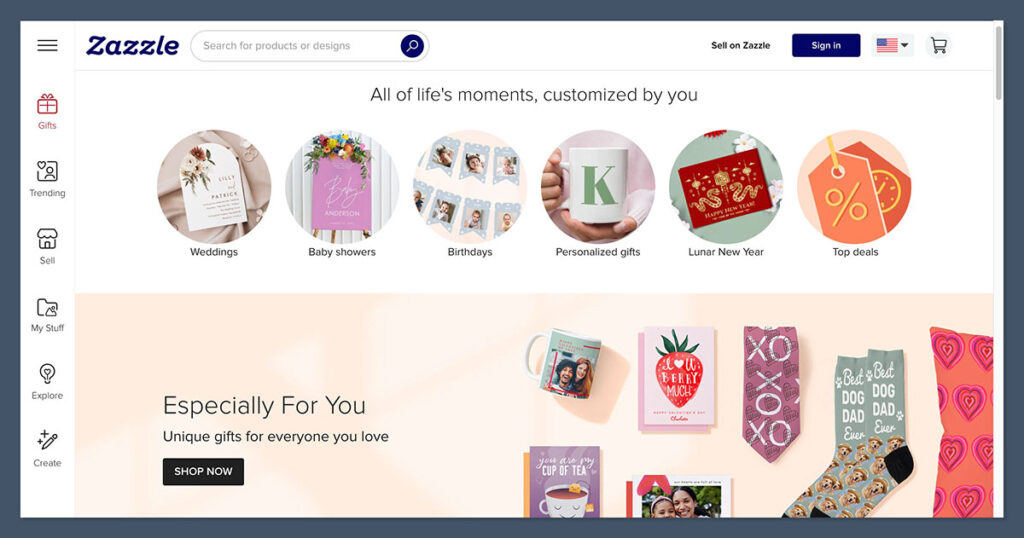
### Printful vs. Redbubble vs. Zazzle
Zazzle has over 1,300 products to customize and 30+ million customers in their marketplace. Unlike Printful, Zazzle is a marketplace and POD service like Redbubble.
Features:
- Designer royalties 5% to 99%
- Built in design tools with templates
- Multiple storefront options
- Community of independent designers
- Volume discounts up to 60%
Shipping times 24 hours to 10 days like Printful and Redbubble. Zazzle has facilities in the US and fulfillment centers globally.
Zazzle has social features and allows designers to sell their designs for others to use. No monthly fees but they take a percentage of sales. Bulk order discounts make them cheaper for large orders.
Printful vs. Redbubble vs. Teespring
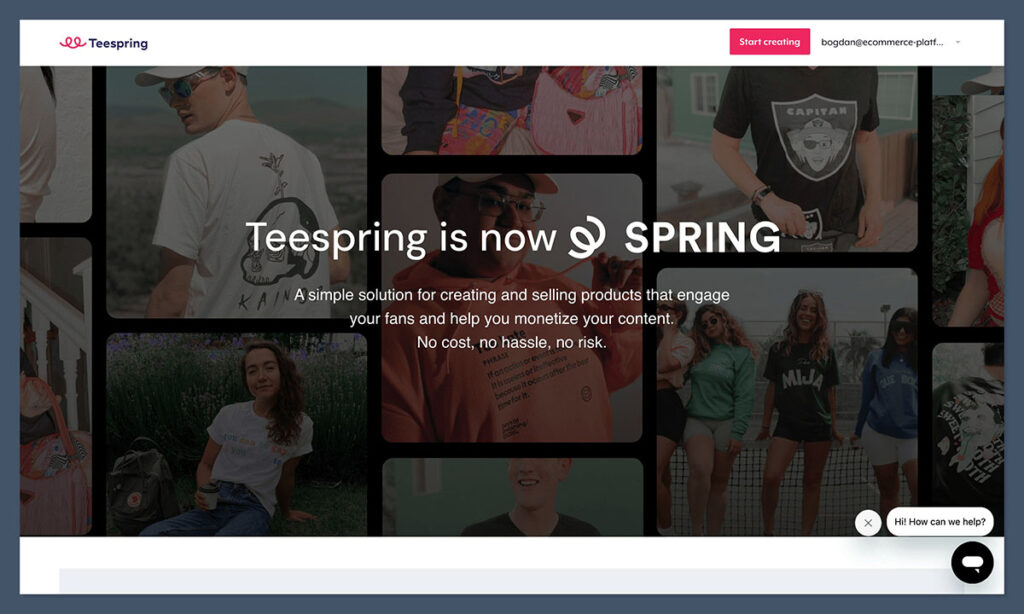
Teespring has 50 kind of products to choose from. While this is less than Redbubble’s 60 or Printful’s 370+, you still receive similar design tools, including:
- An easy-to-use interface
- Access to on-site design tools
- Access to text, images, and design templates
In terms of pricing, Teespring works just like other PODs, where the product’s base price is deducted from the retail price you’ve set.
TeeSpring offers valuable integrations like YouTube Merch Shelf, the Twitch Merch Store, Streamlabs, and even Discord.
In addition, Printful has a vaster range to choose from. Teespring’s exclusive integrations with the channels mentioned above are a great way to market your products, especially if you are a creator selling merchandise on Youtube or Twitch.
When it comes to shipping, like Printful, Teespring offers a range of global fulfillment options with shipping costs based on location.
Printful vs Redbubble – Which is The Best Print on Demand Solution?
So, there you have it, our Printful vs Redbubble review. So, which is better?
Of course, both Printful and Redbubble enable you to create and sell custom products. But, all in all, we think, Printful takes the crown.
Printful's sheer array of integrations, its mockup generator, branding options, and the control you have over your customer's shipping fees gives the platform a slight edge over Redbubble.
Having read this review, we hope you have a better idea of which of these print on demand platforms best suits your needs.
Which will you opt for, Printful or Redbubble?
Or, are you considering one of their competitors like Printify, Teepublic, Spreadshirt, Zazzle, or Teespring? Whichever you decide, let us know how you get on in the comments box below!




Hi, thanks for the review, very useful! I tried them both and would like to add something…
In my opinion, Printful is “technically” better. For example, in the editor mode, they tell you if the picture you are using is of the right quality or not. Also, your pictures/artworks are stored in folders and you can easily recall them to create new products. Then, mockups are awesome.
But what I like better in Redbubble is that it’s very “practical”. I don’t have to bother creating my own shop online and connect manually each product to the related Printful product. Mass editing is a huge time-saving feature.
Probably I would go Redbubble if you are just started and don’t want to put too much time into your personal little entrepreneurship adventure. While if you want to start a little bit more structured, with a real online shop and create your brand, I wuld definitely suggest Printful.
Have a great day!
Thanks for sharing!
A load of information, thanks 😊
Happy to help Tina!
I’ve used both platforms. The clearest way I can crosscut and see the difference is brand awareness. Using Printful with your website, people are coming to you and buying your products. They aren’t seeing competitors similar products. They are getting to know and care for your brand and you as an artist.
With Redbubble, most of the people probably never really get to know the individual brand. It’s a Redbubble product to them on a Redbubble website and products are shipped as Redbubble. You may get sales from global searches within the network but you can also get lost in the sea of competition. You won’t have too many people going to the artists storefront purchasing related products. With PF and website, you can building your brand through peripheral activities like behind-the-scenes content such as blog posts.
A big reason I’m not using RB is that you have way less control over the products. For example, I have black line illustrations on a clear background. This works great on light fabrics but is lost on dark fabrics. There’s no way to prevent people from ordering dark on dark or light on light. It shows up as a ridiculous option.